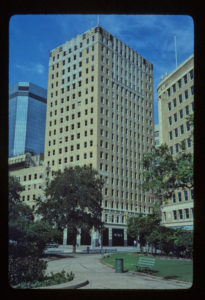 410 W. Seventh Street [NR/Sky (NR)], Electric Building and Electric Building Annex (Hollywood Theatre) / 410 W. Seventh Building, 1929-30; 1979. Erected in 1929-30 to house the Texas Electric Service Co., this building was designed by Fort Worth architect Wyatt C. Hedrick. Houston developer Jesse H. Jones, who operated locally through the Fort Worth Properties Corporation, owned the site overlooking Burnett Park on the northeast corner of W. Seventh and Lamar. L.E. Myers Co. of Chicago was the general contractor for the project. The electric skyscraper has a base of granite with cut stone on the first two floors and cream colored brick above. Cast concrete ornamentation is contained in graceful vertical piers beginning at the fifteenth floor and in horizontal frieze bands at the top and bottom of the building. A recurring decorative motif is a hand grasping bolts of electricity alluding to the utility company which was the tower’s primary tenant.
410 W. Seventh Street [NR/Sky (NR)], Electric Building and Electric Building Annex (Hollywood Theatre) / 410 W. Seventh Building, 1929-30; 1979. Erected in 1929-30 to house the Texas Electric Service Co., this building was designed by Fort Worth architect Wyatt C. Hedrick. Houston developer Jesse H. Jones, who operated locally through the Fort Worth Properties Corporation, owned the site overlooking Burnett Park on the northeast corner of W. Seventh and Lamar. L.E. Myers Co. of Chicago was the general contractor for the project. The electric skyscraper has a base of granite with cut stone on the first two floors and cream colored brick above. Cast concrete ornamentation is contained in graceful vertical piers beginning at the fifteenth floor and in horizontal frieze bands at the top and bottom of the building. A recurring decorative motif is a hand grasping bolts of electricity alluding to the utility company which was the tower’s primary tenant.
The Electric Building Annex, north of the main structure, was constructed shortly after the main building to the house the Hollywood Theatre and additional office space. Wyatt C. Hedrick also designed this structure, which was built by the R.F. Hill Construction Co. Inside the building, the Hollywood Theatre was designed by Alfred C. Finn of Houston. The theatre was an eclectic display of Zigzag Moderne design coupled with elements more reminiscent of Georgian architecture.
Texas Electric gave the building to Texas Wesleyan College in 1968; First National Bank (later Interfirst) purchased it in 1974. The Hollywood Theatre closed in 1976 and, in 1979, Interfirst installed a minibank inside the auditorium, removing the seats and covering over many of the decorative elements. The original theater entrance on W. Seventh St. was also closed off. Dropped ceilings and interior walls constructed for the bank have since been removed, and a substantial portion of the theatre remains hidden inside the building. Although the ground floor windows and entrances have been altered and some of the theatre’s interior features were damaged when the bank interior was constructed, the building may be eligible for the National Register on the basis of its architectural design. it is also a contributor to the proposed Downtown Skyscrapers National Register Thematic Group.
